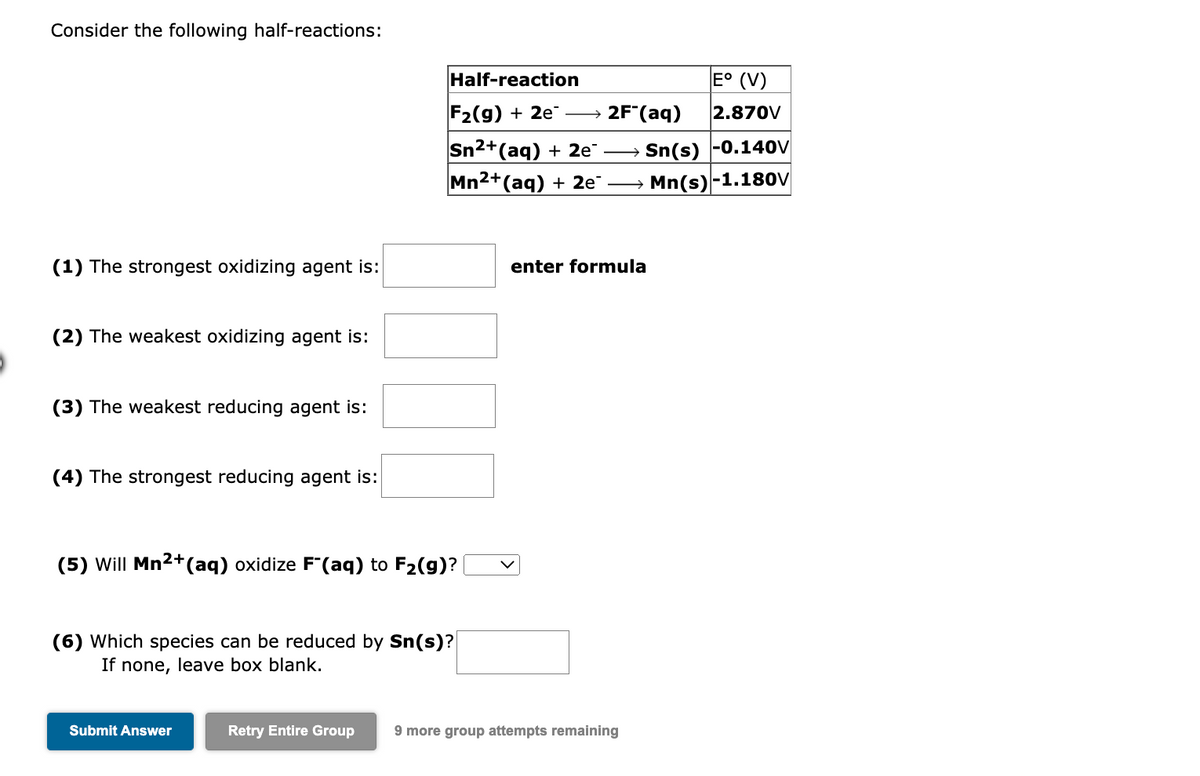Consider the following half-reactions: (1) The strongest oxidizing agent is: (2) The weakest oxidizing agent is: (3) The weakest reducing agent is: (4) The strongest reducing agent is: (5) Will Mn²+ (aq) oxidize F"(aq) to F₂(g)? Half-reaction F₂(g) + 2e →→→ 2F (aq) Sn2+(aq) + 2e™ Mn2+ (aq) + 2e™ E° (V) 2.870V Sn(s) -0.140V Mn(s)-1.180V enter formula
Consider the following half-reactions: (1) The strongest oxidizing agent is: (2) The weakest oxidizing agent is: (3) The weakest reducing agent is: (4) The strongest reducing agent is: (5) Will Mn²+ (aq) oxidize F"(aq) to F₂(g)? Half-reaction F₂(g) + 2e →→→ 2F (aq) Sn2+(aq) + 2e™ Mn2+ (aq) + 2e™ E° (V) 2.870V Sn(s) -0.140V Mn(s)-1.180V enter formula
General Chemistry - Standalone book (MindTap Course List)
11th Edition
ISBN:9781305580343
Author:Steven D. Gammon, Ebbing, Darrell Ebbing, Steven D., Darrell; Gammon, Darrell Ebbing; Steven D. Gammon, Darrell D.; Gammon, Ebbing; Steven D. Gammon; Darrell
Publisher:Steven D. Gammon, Ebbing, Darrell Ebbing, Steven D., Darrell; Gammon, Darrell Ebbing; Steven D. Gammon, Darrell D.; Gammon, Ebbing; Steven D. Gammon; Darrell
Chapter19: Electrochemistry
Section: Chapter Questions
Problem 19.143QP: Consider the following cell running under standard conditions: Fe(s)Fe2+(aq)Al3+(aq)Al(s) a Is this...
Related questions
Question
6

Transcribed Image Text:Consider the following half-reactions:
(1) The strongest oxidizing agent is:
(2) The weakest oxidizing agent is:
(3) The weakest reducing agent is:
(4) The strongest reducing agent is:
(5) Will Mn²+ (aq) oxidize F"(aq) to F₂(g)?
(6) Which species can be reduced by Sn(s)?
If none, leave box blank.
Submit Answer
Half-reaction
F₂(g) + 2e
Sn²+(aq) + 2e¯ →
Mn²+(aq) + 2e¯ →
enter formula
E° (V)
2.870V
Sn(s) -0.140V
Mn(s)-1.180V
2F (aq)
Retry Entire Group 9 more group attempts remaining
Expert Solution
This question has been solved!
Explore an expertly crafted, step-by-step solution for a thorough understanding of key concepts.
This is a popular solution!
Trending now
This is a popular solution!
Step by step
Solved in 2 steps with 2 images

Knowledge Booster
Learn more about
Need a deep-dive on the concept behind this application? Look no further. Learn more about this topic, chemistry and related others by exploring similar questions and additional content below.Recommended textbooks for you

General Chemistry - Standalone book (MindTap Cour…
Chemistry
ISBN:
9781305580343
Author:
Steven D. Gammon, Ebbing, Darrell Ebbing, Steven D., Darrell; Gammon, Darrell Ebbing; Steven D. Gammon, Darrell D.; Gammon, Ebbing; Steven D. Gammon; Darrell
Publisher:
Cengage Learning

Chemistry: The Molecular Science
Chemistry
ISBN:
9781285199047
Author:
John W. Moore, Conrad L. Stanitski
Publisher:
Cengage Learning

Chemistry: Principles and Practice
Chemistry
ISBN:
9780534420123
Author:
Daniel L. Reger, Scott R. Goode, David W. Ball, Edward Mercer
Publisher:
Cengage Learning

General Chemistry - Standalone book (MindTap Cour…
Chemistry
ISBN:
9781305580343
Author:
Steven D. Gammon, Ebbing, Darrell Ebbing, Steven D., Darrell; Gammon, Darrell Ebbing; Steven D. Gammon, Darrell D.; Gammon, Ebbing; Steven D. Gammon; Darrell
Publisher:
Cengage Learning

Chemistry: The Molecular Science
Chemistry
ISBN:
9781285199047
Author:
John W. Moore, Conrad L. Stanitski
Publisher:
Cengage Learning

Chemistry: Principles and Practice
Chemistry
ISBN:
9780534420123
Author:
Daniel L. Reger, Scott R. Goode, David W. Ball, Edward Mercer
Publisher:
Cengage Learning

Chemistry by OpenStax (2015-05-04)
Chemistry
ISBN:
9781938168390
Author:
Klaus Theopold, Richard H Langley, Paul Flowers, William R. Robinson, Mark Blaser
Publisher:
OpenStax

Principles of Modern Chemistry
Chemistry
ISBN:
9781305079113
Author:
David W. Oxtoby, H. Pat Gillis, Laurie J. Butler
Publisher:
Cengage Learning

Chemistry & Chemical Reactivity
Chemistry
ISBN:
9781133949640
Author:
John C. Kotz, Paul M. Treichel, John Townsend, David Treichel
Publisher:
Cengage Learning